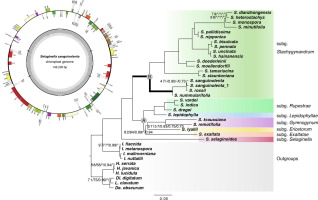当前位置:
X-MOL 学术
›
Mol. Phylogenet. Evol.
›
论文详情
Our official English website, www.x-mol.net, welcomes your feedback! (Note: you will need to create a separate account there.)
Plastome-based phylogenomics resolves the placement of the sanguinolenta group in the spikemoss of lycophyte (Selaginellaceae).
Molecular Phylogenetics and Evolution ( IF 4.1 ) Pub Date : 2020-03-12 , DOI: 10.1016/j.ympev.2020.106788 Hong-Rui Zhang 1 , Ran Wei 1 , Qiao-Ping Xiang 1 , Xian-Chun Zhang 1
Molecular Phylogenetics and Evolution ( IF 4.1 ) Pub Date : 2020-03-12 , DOI: 10.1016/j.ympev.2020.106788 Hong-Rui Zhang 1 , Ran Wei 1 , Qiao-Ping Xiang 1 , Xian-Chun Zhang 1
Affiliation

|
Selaginellaceae have been shown to be monophyletic in previous studies, and include only the single genus Selaginella. However, the two most recent classifications of the genus disagree in terms of the number of subgenera recognized, and the position of problematic clades such as the "sanguinolenta" group, which has been resolved in quite different positions in different studies. Here, we performed a plastid-genome based phylogenomic analysis of Selaginellaceae to address this problem. The sanguinolenta group, represented here by three species, was resolved as sister to the remaining members of subg. Stachygynandrum. Additionally, subg. Exaltatae, subg. Ericetorum, and subg. Gymnogynum in clade A clustered into a well supported monophyletic clade but with conflicting topology between subgenera inside, which is possibly attributed to the early divergence among them. We uncovered substantial variation in both synonymous (dS) and nonsynonymous (dN) substitution rate, and GC content in plastomes of Selaginellaceae. The values of dS, dN, and GC content were significantly higher than those of other lycophytes (Isoetaceae and Lycopodiaceae). We observed a significant positive correlation between the high GC content, and the elevated dS and dN rates. In addition, the dS and dN values inferred among branches of Selaginellaceae were extremely variable. Our data indicate that this unevenly distributed substitution rate likely reflected relaxed or intensified selection among different lineages, which is possibly related to the inconsistency of the subgeneric phylogenetic topologies of Selaginellaceae.
中文翻译:

基于Plastome的系统基因组学解决了Sanguinolenta组在藻类植物(Selaginellaceae)的穗状花序中的位置。
卷柏科在先前的研究中已经证明是单系的,并且仅包括卷柏属一个。但是,该属的两个最新分类在所识别的亚属的数量以及有问题的进化枝(例如“ sanguinolenta”组)的位置方面存在分歧,在不同的研究中,该进化枝在不同的位置已得到解决。在这里,我们进行了针对卷柏科的基于质体基因组的系统生物学分析,以解决该问题。Sanguinolenta组,这里以三个物种为代表,已被确定为subg其余成员的姐妹。水母。此外,subg。Exaltatae,subg。ice草科和subg。进化枝A中的裸子植物群集成一个支撑良好的单系进化枝,但内部亚属之间的拓扑相互矛盾,这可能是由于它们之间的早期分歧。我们发现了卷柏科的质体中同义(dS)和非同义(dN)替代率以及GC含量的实质性变化。dS,dN和GC含量的值显着高于其他藻类(Isoetaceae和Lycopodiaceae)。我们观察到高GC含量与dS和dN速率升高之间存在显着的正相关。另外,在卷柏科的分支之间推断的dS和dN值变化很大。我们的数据表明,这种分布不均的替代率可能反映了不同谱系之间选择的放松或加剧,这可能与卷柏科的亚属系统发育拓扑结构的不一致有关。我们发现了卷柏科的质体中同义(dS)和非同义(dN)替代率以及GC含量的实质性变化。dS,dN和GC含量的值显着高于其他藻类(Isoetaceae和Lycopodiaceae)。我们观察到高GC含量与dS和dN速率升高之间存在显着的正相关。此外,在卷柏科的分支之间推断的dS和dN值变化很大。我们的数据表明,这种分布不均的替代率可能反映了不同谱系之间选择的放松或加剧,这可能与卷柏科的亚属系统发育拓扑结构的不一致有关。我们发现了卷柏科的质体中同义(dS)和非同义(dN)替代率以及GC含量的实质性变化。dS,dN和GC含量的值显着高于其他藻类(Isoetaceae和Lycopodiaceae)。我们观察到高GC含量与dS和dN速率升高之间存在显着的正相关。此外,在卷柏科的分支之间推断的dS和dN值变化很大。我们的数据表明,这种分布不均的替代率可能反映了不同谱系之间选择的放松或加剧,这可能与卷柏科的亚属系统发育拓扑结构的不一致有关。dS,dN和GC含量的值显着高于其他藻类(Isoetaceae和Lycopodiaceae)。我们观察到高GC含量与dS和dN速率升高之间存在显着的正相关。另外,在卷柏科的分支之间推断的dS和dN值变化很大。我们的数据表明,这种分布不均的替代率可能反映了不同谱系之间选择的放松或加剧,这可能与卷柏科的亚属系统发育拓扑结构的不一致有关。dS,dN和GC含量的值显着高于其他藻类(Isoetaceae和Lycopodiaceae)。我们观察到高GC含量与dS和dN速率升高之间存在显着的正相关。此外,在卷柏科的分支之间推断的dS和dN值变化很大。我们的数据表明,这种分布不均的替代率可能反映了不同谱系之间选择的放松或加剧,这可能与卷柏科的亚属系统发育拓扑结构的不一致有关。卷柏科之间的dS和dN值变化很大。我们的数据表明,这种分布不均的替代率可能反映了不同谱系之间选择的放松或加剧,这可能与卷柏科的亚属系统发育拓扑结构的不一致有关。卷柏科之间的dS和dN值变化很大。我们的数据表明,这种分布不均的替代率可能反映了不同谱系之间选择的放松或加剧,这可能与卷柏科的亚属系统发育拓扑结构的不一致有关。
更新日期:2020-03-12
中文翻译:

基于Plastome的系统基因组学解决了Sanguinolenta组在藻类植物(Selaginellaceae)的穗状花序中的位置。
卷柏科在先前的研究中已经证明是单系的,并且仅包括卷柏属一个。但是,该属的两个最新分类在所识别的亚属的数量以及有问题的进化枝(例如“ sanguinolenta”组)的位置方面存在分歧,在不同的研究中,该进化枝在不同的位置已得到解决。在这里,我们进行了针对卷柏科的基于质体基因组的系统生物学分析,以解决该问题。Sanguinolenta组,这里以三个物种为代表,已被确定为subg其余成员的姐妹。水母。此外,subg。Exaltatae,subg。ice草科和subg。进化枝A中的裸子植物群集成一个支撑良好的单系进化枝,但内部亚属之间的拓扑相互矛盾,这可能是由于它们之间的早期分歧。我们发现了卷柏科的质体中同义(dS)和非同义(dN)替代率以及GC含量的实质性变化。dS,dN和GC含量的值显着高于其他藻类(Isoetaceae和Lycopodiaceae)。我们观察到高GC含量与dS和dN速率升高之间存在显着的正相关。另外,在卷柏科的分支之间推断的dS和dN值变化很大。我们的数据表明,这种分布不均的替代率可能反映了不同谱系之间选择的放松或加剧,这可能与卷柏科的亚属系统发育拓扑结构的不一致有关。我们发现了卷柏科的质体中同义(dS)和非同义(dN)替代率以及GC含量的实质性变化。dS,dN和GC含量的值显着高于其他藻类(Isoetaceae和Lycopodiaceae)。我们观察到高GC含量与dS和dN速率升高之间存在显着的正相关。此外,在卷柏科的分支之间推断的dS和dN值变化很大。我们的数据表明,这种分布不均的替代率可能反映了不同谱系之间选择的放松或加剧,这可能与卷柏科的亚属系统发育拓扑结构的不一致有关。我们发现了卷柏科的质体中同义(dS)和非同义(dN)替代率以及GC含量的实质性变化。dS,dN和GC含量的值显着高于其他藻类(Isoetaceae和Lycopodiaceae)。我们观察到高GC含量与dS和dN速率升高之间存在显着的正相关。此外,在卷柏科的分支之间推断的dS和dN值变化很大。我们的数据表明,这种分布不均的替代率可能反映了不同谱系之间选择的放松或加剧,这可能与卷柏科的亚属系统发育拓扑结构的不一致有关。dS,dN和GC含量的值显着高于其他藻类(Isoetaceae和Lycopodiaceae)。我们观察到高GC含量与dS和dN速率升高之间存在显着的正相关。另外,在卷柏科的分支之间推断的dS和dN值变化很大。我们的数据表明,这种分布不均的替代率可能反映了不同谱系之间选择的放松或加剧,这可能与卷柏科的亚属系统发育拓扑结构的不一致有关。dS,dN和GC含量的值显着高于其他藻类(Isoetaceae和Lycopodiaceae)。我们观察到高GC含量与dS和dN速率升高之间存在显着的正相关。此外,在卷柏科的分支之间推断的dS和dN值变化很大。我们的数据表明,这种分布不均的替代率可能反映了不同谱系之间选择的放松或加剧,这可能与卷柏科的亚属系统发育拓扑结构的不一致有关。卷柏科之间的dS和dN值变化很大。我们的数据表明,这种分布不均的替代率可能反映了不同谱系之间选择的放松或加剧,这可能与卷柏科的亚属系统发育拓扑结构的不一致有关。卷柏科之间的dS和dN值变化很大。我们的数据表明,这种分布不均的替代率可能反映了不同谱系之间选择的放松或加剧,这可能与卷柏科的亚属系统发育拓扑结构的不一致有关。



























 京公网安备 11010802027423号
京公网安备 11010802027423号